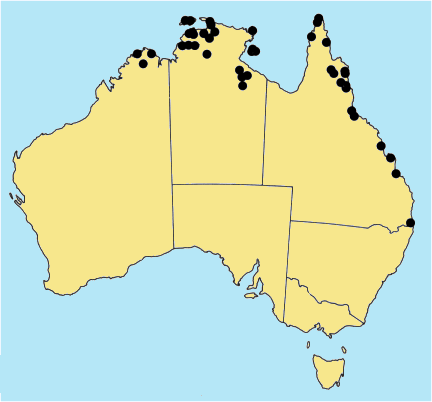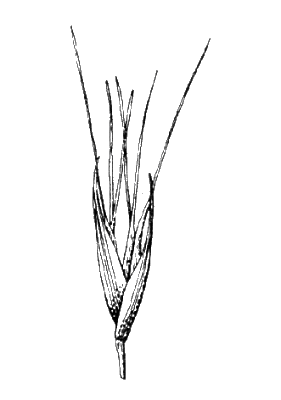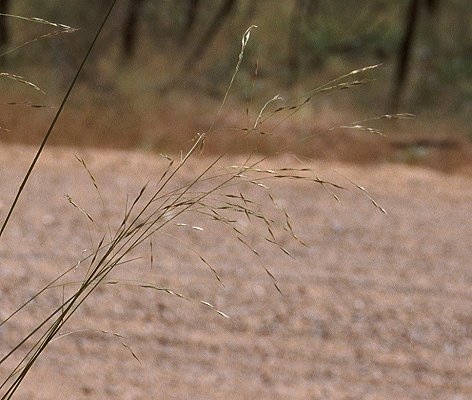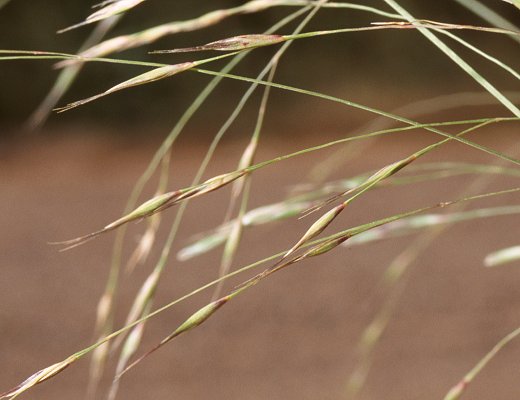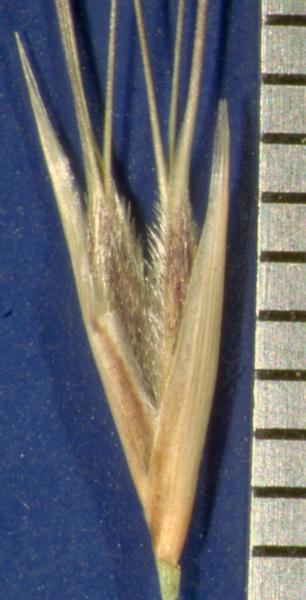Eriachne triseta Nees ex Steud. Syn. Pl. Glum. 1:237(1854).
Classification. (GPWG 2001) : Subfamily Micrairoideae. Eriachneae.
Type of Basionym or
Protologue Information: Sri Lanka: Walker (P holo, K).
Key references
(books and floras): [1969] E.E.Henty, Manual Grasses New Guinea
(100), [2002] D.Sharp & B.K.Simon, AusGrass, Grasses of Australia.
Habit. Perennial.
Culms erect, 50–120 cm tall, wiry. Mid-culm nodes glabrous. Lateral branches
simple or branched. Ligule a fringe of hairs. Leaf-blades straight, convolute,
5–25 cm long, 1–2 mm wide. Leaf-blade surface scabrous, glabrous.
Inflorescence.
Inflorescence compound, a panicle. Panicle ovate, 7–15 cm long, (1–)25–45 cm
wide.
Spikelets.
Spikelets pedicelled. Fertile spikelets 2-flowered, both fertile, comprising 2
fertile floret(s), without rachilla extension, ovate, laterally compressed,
1–1.25 mm long.
Glumes.
Glumes similar, thinner than fertile lemma. Lower glume lanceolate, membranous,
without keels, 10–13 -nerved. Lower glume surface glabrous. Lower glume apex
muticous or mucronate. Upper glume lanceolate, 9.5–15 mm long, membranous,
without keels, 10–13 -nerved. Upper glume surface smooth, glabrous. Upper glume
apex muticous or mucronate.
Florets.
Fertile lemma 5–7 mm long, without keel, 5–7 -nerved. Lemma surface indumented.
Lemma apex awned, 1 -awned. Median (principal) awn 8–18 mm long overall. Palea
2 -nerved. Palea apex dentate, awned (2). Anthers 2. Grain 2.8–4 mm long.
Continental
Distribution: Tropical Asia and Australasia.
Australian
Distribution: Western Australia, Northern Territory, Queensland.
Western Australia:
Gardner. Northern Territory: Darwin & Gulf. Queensland: Cook,
Moreton, North Kennedy, Port Curtis, South Kennedy.
Notes.
The two well-developed awns on the palea is rare, but not unique in the genus.
The plants are tussock-forming mostly glabrous perennials, with setaceous
finely pointed often flexuose blades. The spreading panicle of drooping,
divided primary branches is relatively sparse. The glumes are glabrous,
many-nerved, and usually unequal due to their oblique attachment. The florets
(excluding awns) are shorter than the glumes, with appressed lemma and palea,
and an acute relatively long hairy callus. The lemmas are cartilaginous with
narrow hyaline margins, appressedly pubescent on the surface and ciliate on the
submargins, without grooves, and with a well-developed awn slightly longer than
the two awns on the palea, which has a pubescent body and glabrous keels and
flaps.
Native.
In Australia, Kimberley region of W.A., and N of the Tropic of Capricorn in Qld
and N.T.; also in Sri Lanka, India and throughout Southeast Asia. A common
plant of sandy seasonally flooded habitats (floodplains, seepage slopes, along
creeks, and the margins of fresh-water marshes, swamps, springs in gorge
floors, lakes and billabongs); also recorded from coastal sand dunes, rocky
hillslopes, and plateaux, often in association with sandstone and laterite.
Flowers and fruits Dec.-Aug. (summer to winter).
